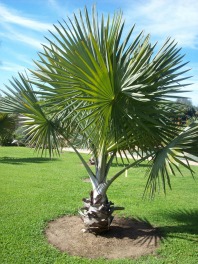Planting Palm Trees
Outdoor palms planted in the ground grow mostly in tropical and subtropical climates. Potted palm trees are portable; easy to move indoors for overwintering, allowing you to enjoy a touch of the tropics no matter where you live.
When purchased from a nursery, palms are either sold in pots or with their root balls rapped in burlap. Palm trees should be planted in new containers or in the landscape as soon as possible. If you have to delay planting, be sure to keep the palm’s roots evenly moist.
Be careful when transporting and handling palm trees – damage to bark and root balls can leave palm trees vulnerable to pests and diseases. Keep in mind; the best time for planting palms is during warm months (minimum soil temperature of 65° F / 18° C).
Planting Palm Trees - Palm Tree Selection
The most important factors to consider are sun and cold tolerance. Before buying a palm tree, make sure it will
survive in your climate. It is a good idea to purchase locally grown
palm trees. Imported palm trees might require conditions that are not
possible for you to provide.
Before buying a palm tree, make sure it will
survive in your climate. It is a good idea to purchase locally grown
palm trees. Imported palm trees might require conditions that are not
possible for you to provide.Size is the next factor in the palm selection process. There are benefits and drawbacks to purchasing all sizes.
Small palm trees will take longer to reach their full size and can be vulnerable to cold temperatures; however, they are easy to handle and transport. They are also less expensive than their larger counterparts.
Medium palm trees cost a little more; however, they are sturdier than smaller palms and reach their full size in a shorter amount of time.
Although large palm trees cost more than small and medium plants, they make the biggest impact to the landscape because of their size and are easier to acclimate.
Planting Palm Trees - Repotting Container Palms
In general, indoor palm trees only need to be repotted once every three years. Palms with crowded roots can be good since this can limit growth if you are you will be keeping them inside.
Repotting is necessary to alleviate severe root crowding, to promote growth, and to provide palm with a fresh supply of potting medium.
Avoid planting palm trees too deeply. Be aware that brittle roots can break easily. Handle them with care. Soil should be packed repeatedly around the roots. Be sure to flush the container thoroughly with water.
Propagating
While most palms grow from seeds, some species (lady palms) grow clumps that can be propagated by division.
You can grow palms from seeds if you have a very warm location for them. To test a palm seed for freshness, drop it into a pail of water. If it floats it should be discarded. A fresh seed will germinate better than an old one.
Use a small 2 in / 5 cm pot. Plant the seed near the surface – barely cover it. The germination process can take anywhere from a few days to several months. Temperatures should be between 75 - 80° F / 24 - 27° C.
Enclose the container in a plastic bag, and store it on top of a hot-water heater or refrigerator. Transplant the seedling when it has two or more leaves. If seeds are planted in early spring, they can spend their first summer outside.
Tips for Planting Palm Trees in the Landscape
Dig a hole twice the diameter of the root ball. Make sure the hole is deep enough so that the root ball will be sufficiently covered. After the tree is placed into the hole, backfill with the freshly dug soil.Add a soil treatment to the palm, such as Mycorrhizal fungi. This will help the roots of the palm to absorb much needed nutrients. Liquid forms of this treatment are available in containers that look like aspirin bottles and can be found at nurseries.
After the palm tree has been planted, build a soil barrier around the hole to form a dam that will hold water. Add a layer of organic mulch around the base of the tree (approximately 3 inches deep).
Planting Palm Trees – Palm Tree Maintenance
Frequent watering is essential after palms have been planted. Newly planted palm trees should be watered every day for the first week, every other day in the second week, and two to three times per week thereafter. Consider using a bubbler or arranging a hose around the base of the palm. It is important to keep soil moist, do not let it become dry.
Do not fertilize newly planted palm trees until new growth appears – approximately six to eight weeks after planting.
After palm is established, apply fertilizer during the growing season (approximately three to four applications). A single application of a high-quality, continual-release formula will feed your palm for a few months at a time.
Avoid damage to palm tree bark when using lawn mowers and weed-whackers. Bark damage leaves trees susceptible to pests and diseases.
Additional Palm Tree Information
Indoor Palm Tree Care - Basic Tips and InformationOutdoor Palm Tree Care - How to Grow and Care for Outdoor Palms
Growing Palm Trees - Advice for Palm Tree Selection and Care





